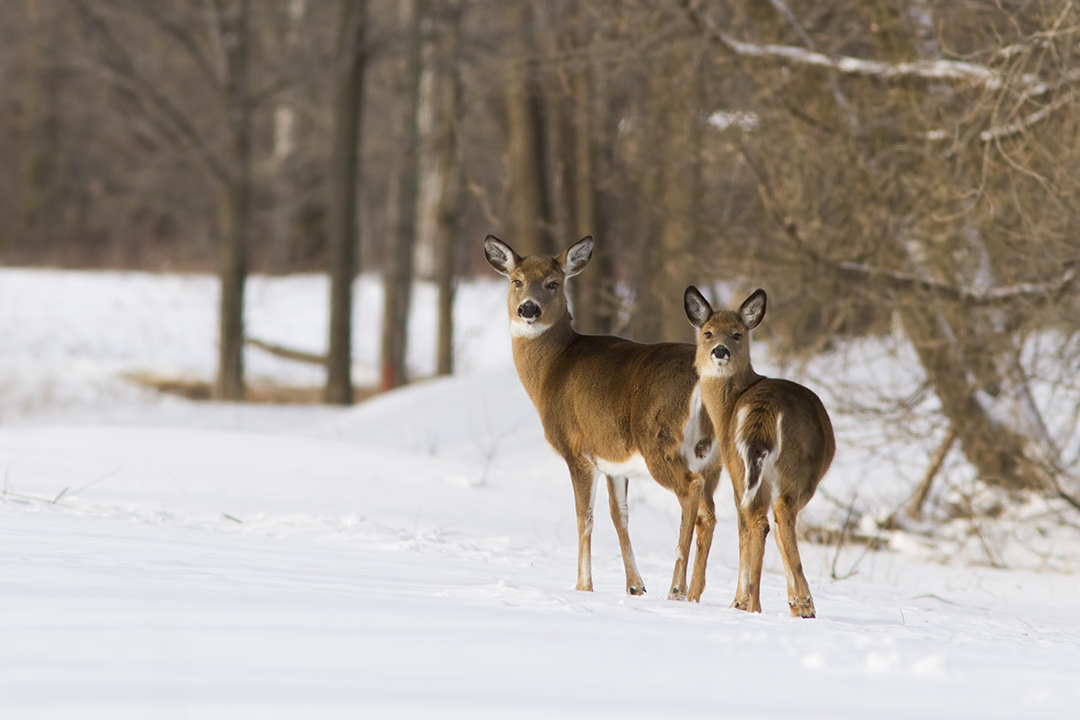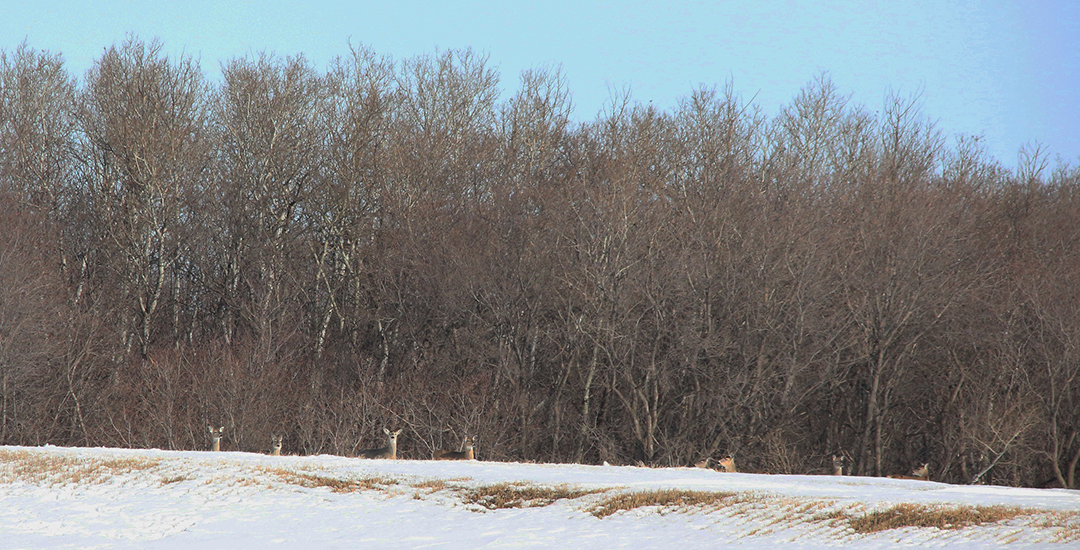
Surveillance team detects SARS-CoV-2 virus in Saskatchewan white-tailed deer
Nearly two years after academic, provincial and federal researchers pooled resources to build a wildlife surveillance program, there’s proof that SARS-CoV-2 virus is circulating among free-ranging, white-tailed deer in Saskatchewan.
By Myrna MacDonaldThe team, whose members are from the University of Saskatchewan (USask), Environment and Climate Change Canada (ECCC), Saskatchewan Ministry of Environment, and Canadian Wildlife Health Cooperative (CWHC), found positive results in viral RNA swabs taken from four white-tailed deer harvested in 2021.
The National Centre for Foreign Animal Disease (NCFAD) confirmed the positive results, which represent two per cent of 227 white-tailed deer tested in Saskatchewan.
The surveillance team reported that 10 per cent of 62 white-tailed deer tested had SARS-CoV-2 antibodies — indicating previous exposure or active infection.
While white-tailed deer in Ohio and multiple Canadian provinces have tested positive for SARS-CoV-2 virus, the team’s results represent the first detections among Saskatchewan deer.
“For some reason, deer are susceptible to infection, and not only that, when the virus gets into deer it spreads through the population very rapidly,” says Dr. Vikram Misra (PhD), a USask virologist at the Western College of Veterinary Medicine (WCVM).
SARS-CoV-2, the coronavirus that causes COVID-19, is transmissible between people and animals. Once it became widespread in 2020, scientists suspected the virus could inevitably spill over from humans to susceptible animal species.
“The concern is if it gets into a wildlife reservoir, then the virus will obviously change in very, very unpredictable ways. And then there’s always the possibility of it going back into people from this reservoir,” says Misra.
He describes the surveillance project as a “perfect One Health problem,” intersecting animal, human and environmental health and bringing together experts in wildlife health, virology, molecular microbiology, pathology, parasitology, zoonoses and public health.
Dr. Emily Jenkins (DVM, PhD) is a WCVM researcher who conducts wildlife and public health research studies in the North. Early in the pandemic, she received questions from Indigenous people who rely on wildlife for food and livelihoods.
“We initiated this surveillance to reassure people about the wildlife that they’re handling and consuming,” says Jenkins, adding that SARS-CoV-2 isn’t a foodborne virus and the risk of contracting the virus from harvested wildlife is minimal.
Jenkins redirected Dr. Pratap Kafle (DVM, PhD), a postdoctoral fellow in her lab, to investigate molecular testing options. Her graduate student, Connor Rutherford, reviewed the huge wave of new SARS-CoV-2 literature and shortlisted potentially susceptible wildlife. The top four families were cervids (deer family), cricetids (including deer mice), felids (cats) and mustelids (including mink and ferrets).
“Connor’s work lay the foundation for us to decide what animals we should be targeting,” says Jenkins.
Jenkins and Misra worked with Drs. Darryl Falzarano (PhD), Christy Morrissey (PhD) and Trent Bollinger (DVSc) of USask as well as Drs. Catherine Soos (DVM, PhD) and Bruce Pauli of ECCC to obtain grants from Natural Sciences and Engineering Research Council of Canada (NSERC) Alliance, ECCC and the Public Health Agency of Canada.
With support secured, Jenkins’s WCVM lab and the Wildlife Health Lab (managed by Soos) at the ECCC Prairie and Northern Wildlife Research Centre became RNA viral testing sites.
“It has been a great collaboration as our technicians … worked together to develop and validate the testing in both labs,” says Soos, ECCC wildlife health specialist and adjunct professor in the WCVM’s Department of Veterinary Pathology.
Misra and his lab developed a test for identifying SARS-CoV-2 antibodies in blood from various animal species. Most tests for people and animals only detect antibodies against the virus’s spike protein, but this new test also detects a couple of other proteins.
“It’s pretty unique because it takes into account the changes that the virus may undergo in a different species,” says Misra. He credits lab technician Noreen Rapin, who set up and optimized the test, and graduate student Shubham Dutta for their efforts. Their biggest challenge: finding positive and negative blood samples from animals so they could validate their test.
“To do that, you need to infect animals with the virus and then sample them over a period of time,” says Misra, whose lab received help from NCFAD researchers in Winnipeg, Man. “They were great — they sent us samples from hamsters before they were infected with SARS-CoV-2 and then individual paired samples after they were infected over several months.”

Another hurdle was finding wildlife samples. Soos leads Canada’s efforts to conduct surveillance for SARS-CoV-2 and other coronaviruses in wildlife. That role puts Soos in contact with partners who could tap into existing wildlife surveillance or research programs for samples.
“A positive outcome is that co-ordinating, communicating and working closely with all the other relevant agencies and partners across the country has really strengthened Canada’s network and ability to tackle emerging One Health issues,” says Soos.
Dr. Iga Stasiak (DVM), wildlife health specialist with Saskatchewan’s Ministry of Environment, learned of the team’s work through a multi-agency, federal-provincial One Health network. Stasiak helped them partner with the province’s long-term chronic wasting disease (CWD) surveillance program, which also involves the CWHC in Saskatoon, Sask.
“Every year, we have hunters from across Saskatchewan who submit deer heads for CWD testing — we felt that was a great opportunity to collect samples for coronavirus testing,” says Stasiak. “Given that white-tailed deer are susceptible to the virus, we wanted to definitely look for it here in Saskatchewan to see if it was also the case.”
In 2021, technicians collected oral and nasal swabs and blood samples from over 300 deer heads at a Regina processing lab. CWHC (Western/Northern Region) also collected samples from submitted deer and other cervids. To better understand geographic representation, Stasiak’s colleagues produced digital maps of tested deer in the province.
Saskatchewan’s surveillance team is now analyzing samples from ECCC, Parks Canada, B.C., Alberta, Saskatchewan, Manitoba, the Maritimes and northern territories. In the East, teams at Toronto’s Sunnybrook Research Institute test samples from Ontario and Quebec. NCFAD conducts final confirmatory testing for all positive samples in Canada.
So far, Canadian labs have tested over 1,400 samples from cervids with positive results detected in Quebec, Ontario, Manitoba and B.C. Teams will test another 1,600 samples from white-tailed deer, mule deer, moose and elk. Canadian labs have also tested more than 1,600 samples from other wildlife species (all testing negative), with plans to test 2,400 samples in total.
“We are receiving samples from every province and territory, a truly national surveillance effort … and actually contributing to understanding how this virus is moving around and mutating in wildlife,” says Jenkins.
With the virus in the white-tailed deer population, Misra says regular SARS-CoV-2 surveillance of deer and other wildlife species is critical to see if the virus continues spreading and whether any natural barriers will reduce distribution.
“If we eventually figure out how the deer are getting infected and determine the risk of people getting infected and how that happens, we may be able to put measures in place to reduce spread.”
Screening wildlife for every potential emerging pathogen isn’t possible, acknowledges Jenkins. But, by knowing more about coronaviruses, understanding what viruses are in Canada’s wildlife, and learning what species may be more susceptible to infection, wildlife health teams may get “a bit of a head start” on the next emerging event.
“Or maybe even head it off—if we’re lucky,” says Jenkins.
